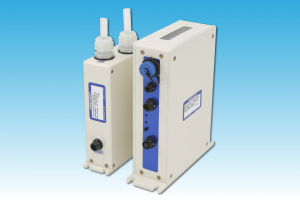

A flow meter is a device used to measure the volume or mass of a gas or liquid. The main benefits of using flow meters are that they can improve the precision and accuracy of routine flow measurements. Here, we explain the working principles of flow meters, the various types available, and highlight our range of flow meter products from Malema.
Flow meters are used to measure the amount of liquid, gas or vapour passing through them. Some flow meters are designed to measure flow based on the amount of fluid passing through the device over a given period of time, such as 100 litres per minute. While others measure the totalised amount of fluid to have passed through the flow meter – 100 litres, for example.
Flow meters generally consist of a primary device, transducer and transmitter. The transducer senses the fluid passing through the primary device, while the transmitter converts the raw transducer signal into a usable flow signal. Flow computers are often used in conjunction with flow meters to compensate for common operational process conditions, like temperature, pressure, viscosity and composition.
The following are among the most popular types of flow meters available on the market today.
Inferential flow meters measure flow by inferring its value from other parameters. Differential pressure, target and variable area flow meters are all types of flow meters that return inferential measurements.
Mass flow meters measure the mass flow of a fluid. Typical examples include Coriolis flow meters, which measure real mass flow, and thermal mass flow meters, which rely on the physical properties of the fluid.
As their name suggests, velocity flow meters measure the velocity of a fluid’s flow to determine the volumetric flow. Popular examples of velocity flow meters include turbine, ultrasonic, magnetic and vortex flow meters.
Volumetric flow meters measure the volume of fluid passing through a flow meter. Positive Displacement (PD) flow meters are the only varieties that directly measure the volume of fluid passing though the flow meter.
Fluid Controls offers an extensive selection of innovative flow meter products from US-based sensor experts, Malema. Among Malema’s impressive range are flow meters for high purity, chemical, bio-medical and industrial applications. Malema was the first manufacturer to introduce all PFA and all PEEK Coriolis mass flow meters, straight tube PFA ultrasonic flow meters, and PFA Paddlewheel flow meters.
Founded in 1981, Malema designs and manufactures flow measurement and control instruments for life sciences, semiconductor and industrial applications. Malema products deliver high accuracy, reliability and repeatability for biopharmaceutical media, abrasive slurries, surfactants, high purity chemicals, and corrosive chemicals. Their SumoFlo® Coriolis flow meters are the industry standard for biopharmaceutical processing.
For more information about our complete range of Malema flow meters, or to discuss your application requirements in more detail, please contact Fluid Controls today on +44 (0)118 970 2060 or email fluid@fluidcontrols.co.uk.